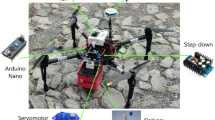Abstract
In order to make the humanoid robot walk freely in complicated circumstance, the reliable capabilities for obtaining plane information from its surroundings are demanded. A system for extracting planes from data taken by stereo vision was presented. After the depth image was obtained, the pixels of each line were scanned and split into straight line segments. The neighbouring relation of line segments was kept in link structure. The groups of three line segments were selected as seed regions. A queue was maintained for storing seed regions, and then the plane region was expanded around the seed region. The process of region growing continued until the queue of seed regions was empty. After trimming, the edges of the planes became smooth. In the end, extracted planes were obtained. In the experiment, two models were used: pipe and stairs. Two planes in pipe model and six planes in stairs model were extracted exactly. The speed and precision of algorithm can satisfy the demands of humanoid robot’s navigation.
Similar content being viewed by others
References
GUTMANN J S, FUKUCHI M, FUJITA M. Stair climbing for humanoid robots using stereo vision [C]// Int Conf on Intelligent Robots and Systems (IROS). Sendai, Japan, 2004: 1407–1413.
KANEHIRO F, HIRUKAWA H, KANEKO K, KAJITA S, FUJIWARA K, HARADA K, YOKOI K. Locomotion planning of humanoid robots to pass through narrow spaces [C]// Int Conf on Robotics and Automation (ICRA). New Orleans, 2004: 604–609.
GUAN Y, YOKOI K, SIAN N E, TANIE K. Feasibility of humanoid robots stepping over obstacles [C]// Int Conf on Intelligent Robots and Systems (IROS). Sendai, Japan, 2004: 130–135.
CHESTNUTT J, LAU M, CHEUNG G, KUFFNER J, HODGINS J, KANADE T. Footstep planning for the Honda ASIMO humanoid [C]// Proceedings of the IEEE International Conference on Robotics and Automation(ICRA’05). Piscataway, NJ, USA, 2005: 629–634.
KUFFNER J J, KAGAMI S. Dynamically-stable motion planning for humanoid robots [J]. Autonomous Robots, 2002, 12(1): 105–118.
ZONG Ying, SHI Wen, LI Xu. Optimal sagittal gait with ZMP stability during complete walking cycle for humanoid robots [J]. Journal of Control Theory and Applications, 2007, 5(2): 133–138.
ZOU Xiao-bing, CAI Zi-xing, SUN Guo-rung. Non-smooth environment modeling and global path planning for mobile robots [J]. Journal of Central South University of Technology, 2003, 10(3): 248–254.
CHEN Xi, TAN Guan-zheng, JIANG Bin. Real-time optimal path planning for mobile robots based on immune genetic algorithm [J]. Journal of Central South University of Technology: Science and Technology, 2008, 39(3): 577–583. (in Chinese)
GUTMANN J S, FUKUCHI M, FUJITA M. Real-time path planning for humanoid robot navigation [C]// Int Joint Conference on Artificial Intelligence. San Francisco, CA, USA, 2005: 1232–1237.
ZHANG Tong, XIAO Nan-feng. Real-time map building for path planning of a humanoid robot [C]// Asia-Pacific Conference on Information Processing, 2009: 211–214.
OKADA K, KAGAMI S, INABA M, INOUE H. Plane segment finder: Algorithm, implementation and applications [C]// Proceedings of the 2001 IEEE International Conference on Robotics & Automation. Seoul, Korea, 2001: 2120–2125.
CHEN Ze-zhi, PEARS N E, LIANG Bo-jian, McDERMID J. Plane segmentation from two views in reciprocal-polar image space [C]// International Conference on Image Analysis and Recognition. Porto, Portugal, 2004: 638–646.
LUD C, SU L, ZHU F, SHI Z. A general method for omnidirectional stereo camera calibration based on neural network optimizationl [J]. Lecture Notes in Computer Science, 2006, 3972: 383–389.
BANKS J, CORKE P. Quantitative evaluation of matching methods and validity measures for stereo vision [J]. The International Journal of Robotics Research, 2001, 18(3): 512–532.
KAGAMI S, TAKAOKA Y, KIDA Y, NISHIWAKI K, KANADE T. Online dense local 3D world reconstruction from stereo image sequences [C]// Proc of the IEEE/RSJ Int Conf on Intelligent Robots and Systems (IROS’05). Edmonton, Canada, 2005: 2999–3004.
Author information
Authors and Affiliations
Corresponding author
Additional information
Foundation item: Project(60776816) supported by the National Natural Science Foundation of China and Civil Aviation Administration of China; Project (8251064101000005) supported by the Natural Science Foundation of Guangdong Province, China
Rights and permissions
About this article
Cite this article
Zhang, T., Xiao, NF. Plane extraction for navigation of humanoid robot. J. Cent. South Univ. Technol. 18, 627–632 (2011). https://doi.org/10.1007/s11771-011-0740-4
Received:
Accepted:
Published:
Issue Date:
DOI: https://doi.org/10.1007/s11771-011-0740-4




